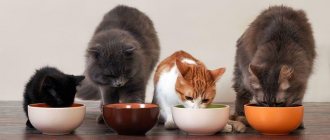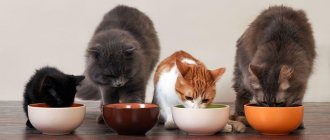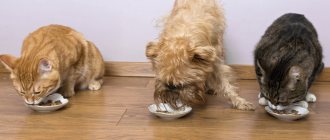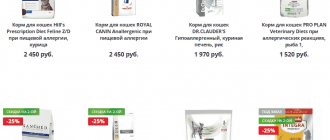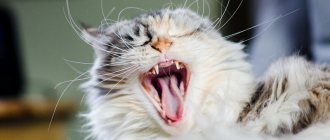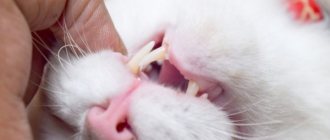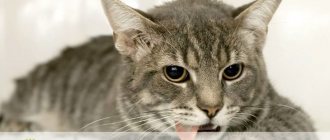There is hardly a single owner who has not observed such a phenomenon as vomiting in a cat . But the cat owner does not always pay due attention to what happened, considering it simply the body’s reaction to food. Yes, this happens, but it also happens that bad changes occur in the cat’s body, and this is one of the first symptoms of a serious illness. Therefore, it is better to figure out whether there is a reason to treat your pet.
Causes of vomiting in cats
There is no single reason for vomiting in cats: it can be a one-time overeating, or the presence of parasites in the body. Vomiting can occur during estrus, in a nursing cat, or in a small kitten. In any case, even a one-time occurrence requires the attention of the owner. Causes include disease, starvation, poisoning and pregnancy in the cat. The closest attention should be paid to repeated vomiting.
global $ads_google; //data-ad-slot=”2475549904″ $ads_google = empty($ads_google) ? false : true; ?> if ($ads_google == false) {?>
$ads_google = true; ?> } ?>
Diseases
Here is a list of diseases that can cause a cat to burp regularly:
- chronic renal failure. Often with chronic renal failure in the morning, the ejected contents consist of empty saliva, and uremic syndrome manifests itself;
- gastroenteritis, gastritis - mucus may be visible;
- infectious diseases - the color of the vomit will be greenish;
- obstruction of the pylorus of the stomach - the animal burps white foam;
- tumors;
- parasitic infestations - the cat vomits mucus;
- inflammatory processes in the gastrointestinal tract;
- pancreatitis;
- peritonitis;
- liver diseases.
More details about the reasons will be shown by the color of the contents and accompanying symptoms. If the problem is not poisoning or a swallowed hairball, then diarrhea, constipation, swelling, and lethargic behavior of the pet may appear.
To visit a doctor, it is better to prepare information about the consistency of the vomit, its color, start time, frequency, contents of the last meals, and your pet’s behavior after regurgitation.
Vomiting fur
Sometimes a cat, for no apparent reason, spews out a ball of fur covered in drool and foam. This is a natural process of cleansing the cat’s body from hairs of fur that have entered the stomach. The wool is not digested, but clumps into clumps that cannot enter the intestines. As a result of the accumulation of hair, a special brain center begins its work, signaling the body to begin the vomiting process. Otherwise, the so-called pilobesoar - a ball of hairs huddled together in a bunch - can clog the digestive tract.
Manifestations and causes
Why is my cat vomiting? This phenomenon is one of the clearest symptoms that something is wrong with the animal. For what reasons does it occur and what diseases may it indicate? Let's look at the main causes of vomiting in cats.
Starvation
If we talk about pets, then most often hungry vomiting is recorded in the morning, when the stomach is empty after the night. As soon as the animal is fed or even given a drink, the vomiting stops.
Binge eating
Often your cat may vomit after eating. And this is the other side of the coin. When the stomach is full, its contents cannot pass into the intestines (after all, the food must be digested) and it returns. And then the cat vomits after eating. Of course, since this food could not fit into the stomach, the cat vomits food or undigested food.
The cat is throwing up hair
Almost every cat owner in his life has encountered the phenomenon of a cat vomiting hair. There's nothing wrong with that. The pet licks itself, the hairs willy-nilly end up in the gastrointestinal tract, which cannot digest the hair.
This hair ball will not pass throughout the intestine, so the vomiting center (and it is present in every mammal’s brain) will give a “command” and reverse peristalsis will begin (that is, the entire contents of the intestine will not go towards the anus, as expected, but will go towards to the mouth). As a result of all this, vomiting begins. This is how hairballs come out of the cat.
If this does not happen, then over time a pilobezoar will form in the intestines - a dense ball of hair that will clog the digestive tract.
Food will no longer be able to move through the gastrointestinal tract, and severe intoxication of the body may begin. The animal will be in great pain. It is not uncommon for a cat to vomit food or undigested food because there is nowhere for the food to “move.”
Such a hair ball can only be removed surgically. Therefore, it is extremely important to give the animal special food that helps remove licked fur from the digestive tract. And be sure to brush your pet regularly. Especially during periods of heavy molting.
Poisoning
Vomiting in cats is a defensive reaction. And if your pet is poisoned, then vomiting will help remove toxins from the body as quickly as possible so that they do not have time to be absorbed and cause harm to the body. But usually vomiting in cats that have been poisoned is accompanied by diarrhea. The intestines are cleansed from all sides at a fast pace.
However, there is a high risk of dehydration. The cat urgently needs help! Poisoning is especially dangerous for young animals and a pregnant cat. If you have this particular case, we recommend reading what to do in case of poisoning in cats.
Vomiting in a pregnant cat
It is no secret that the uterus increases in size while expecting offspring. Due to the fact that there is not much space in the abdominal cavity, other internal organs are compressed and displaced. In addition, during the period of bearing children, the expectant mother has a real hormonal riot. Therefore, vomiting is sometimes observed in a pregnant cat.
But you shouldn’t attribute everything just to a compressed stomach or a change in hormonal levels, especially if the cat vomits very often. Often this becomes a serious symptom. Your pet may have an infectious disease or parasites. Although sometimes diarrhea and vomiting in a cat begins just before birth - a kind of harbinger, but not always. Therefore, if you notice that a pregnant cat has started vomiting, it is better to contact a veterinarian so as not to risk the life of either the mother or the babies.
Infectious and parasitic diseases
Don't forget about them. After all, intestinal parasites are often the reason why a cat’s diarrhea and vomiting practically never stop. Be sure to pay attention to other symptoms. Indeed, with an infectious etiology in a pet, you will notice an increase in body temperature, a change in behavior, and discharge from the eyes and nose. There may be a cough, runny nose.
Diagnosis of cat vomiting
People often forget that it is necessary not only to remove the symptom, but to understand the cause of the phenomenon. Vomit can be a symptom of various disorders in the cat's body. To understand the true cause of regurgitation, you need to look at vomiting - after diagnosis, it will become clear whether the animal requires urgent treatment, and what kind of treatment.
The cat is vomiting blood
When an owner notices blood in a cat's vomit, they may begin to panic. Should not be doing that. You need to get together and first of all study the unpleasant phenomenon.
Perhaps there is scarlet blood in the mass, or the mass itself is thick and brown. If the vomit is still brown, then there is a high chance of gastric bleeding. It could be caused by a foreign body, a tumor, an ulcerative process, liver disease, acute gastritis and some other diseases. Why brown? Because it contains not only blood, but also gastric juice.
Scarlet bloody vomit or a distinct pink mass indicates bleeding in the esophagus or mouth. There is nothing that can be done here other than taking the cat to the clinic.
Black vomit
Black vomit in a cat can also frighten owners. Typically, such a scourge does not manifest itself without accompanying symptoms: along with regurgitation, fever, drowsiness, weakness, pain, diarrhea, and signs of dehydration appear. They do not take any independent action - only a specialist treats the problem. The owner's task is not to try to feed the cat, but to get him to the doctor as soon as possible.
Clear vomit in a cat
Both an adult cat and a small kitten can vomit clear liquid. Instead of the contents of the stomach with pieces of food, there is simply clear water with some gastric juice. A small amount of mucus from the esophagus may be present.
global $ads_google; //data-ad-slot=”2475549904″ $ads_google = empty($ads_google) ? false : true; ?> if ($ads_google == false) {?>
$ads_google = true; ?> } ?>
The causes of the phenomenon are parasites, dyspepsia, swallowed hair that irritates the walls of the esophagus. But not everything is so simple: such regurgitation can be caused by diseases of the thyroid gland, kidneys and cancerous tumors. In this case, it is worth paying attention to the frequency of the phenomenon and other signs.
Vomiting bile
Simple yellow vomit occurs when a cat's diet consists of industrial food. But if the vomit is a bright, rich yellow color, even orange, it means that bile has spilled into the stomach.
Causes
Bile entering the stomach is caused by problems with the biliary tract or liver disease.
Treatment
It is better to re-learn the nutritional tips for cats: fatty foods are completely excluded, not to mention stale ones. The second step will be to consult a veterinarian to check the animal’s condition.
The cat has green vomit
Green vomit appears when a lot of bile or even intestinal contents have splashed into the stomach. Usually the process is triggered by a severe infection. This requires urgent help from a veterinarian, and not treatment at home, take care of your cat!
*Prices do not include medications
The cat vomits white foam and eats nothing
Animal vaccination
Veterinarian help at home
Operations on animals
Therapy for cats and dogs
Surgery for dogs and cats
Euthanasia of animals
Cremation of cats and dogs
Cat vomits yellow liquid
Histology
Skin examination for dermatitis
Blood test for cat, dog
Blood test for babesiosis (cytoplasmosis)
Urine and stool tests
Cytology
Animal tests
Animal blood tests
Skin examination for dermatitis
Blood test for cat, dog
Blood test for cytoplasmosis
Biochemistry of urine
Blood cytology
Blood biochemistry
Stool examination
Diagnostics for animals
Ultrasound of a cat
Ultrasound of a dog
Digital diagnostics of animal diseases
X-ray of animals
Electrocardiography (ECG)
Diagnosis of infectious diseases
Hotel for animals
Temporary care of animals
Day hospital for animals
Intensive therapy
Infectious diseases hospital
24-hour hospital
Hotel for cats
Hotel for dogs
Surgery for animals
Reduction of dislocations in dogs and cats
Sterilization
Castration
C-section
Treatment of fractures and dislocations
Surgical treatment of joints
Urolithiasis disease
Abdominal surgery on animals
Veterinarians
Dermatologist
Oncologist
Ultrasound diagnostic specialist
Dentist
Surgeon
Therapist
Veterinary care at home
Animal therapy at home
Animal surgeries at home
Assistance in childbirth for animals
Emergency vet visit
Groomer at home
Vaccination at home
Phone: +7
What to feed your cat after vomiting
After the cat has vomited, the attentive owner continues not only to monitor the condition of the purr, but will also offer him dietary food. It does not cancel taking medications, but accompanies it. A fasting diet is required in the first 10 hours. Instead of water, after a single nausea, it is better to let the cat lick a couple of ice cubes. Repeated vomiting dehydrates the cat, so you will have to try to give the cat fresh, clean water to drink.
The diet in this case is therapeutic: the stomach and intestines will react poorly to fatty, spicy and salty foods. If the cat eats dry food, medicinal forms are chosen.
The animal is given rice water, baby purees, and boiled chicken for two days in a row.
Symptoms
Foaming at the mouth of a cat is a cause for concern for the animal owner. The cause may be either a normal physiological condition (with regurgitation of hairballs) or the development of serious dangerous diseases (rabies). Especially if the saliva foams at the mouth. In such cases, it is recommended to immediately isolate the cat and take it to a veterinary clinic.
The appearance of foam in a cat’s mouth when vomiting, which occurs as a result of prolonged fasting, intoxication, and stressful experiences, as a rule, is not distinguished by other characteristic signs other than nausea. The erupted gastric contents have no foreign odors or impurities.
If there are foreign impurities in the vomit, an unusual yellow or green color, as well as a foul odor, you must contact a veterinary hospital and show your pet to a doctor. The appearance of the following characteristic symptoms requires immediate intervention from a specialist:
- the cat vomits too often, vomiting almost never stops;
- body temperature increases or, on the contrary, decreases;
- there is a cough, discharge from the eye and nasal cavity;
- appetite is impaired;
- the general condition of the animal is depressed;
- profuse diarrhea appears.
When a cat vomits pink liquid with foam, you cannot hesitate. The cause of such vomiting may be a stomach ulcer or a perforation of the esophagus. Pink color indicates blood impurities and indicates damage to the mucous membrane of one part of the digestive tract.
The color and presence of particles in the vomit can characterize the degree of neglect of the pathological condition:
- vomit with white foam is most often a sign of prolonged starvation of a pet;
- the presence of mucous white inclusions in the liquid ejected by the stomach indicates that the cat is infected with helminths;
- if a cat is vomiting yellow foam, the cause may be a dangerous illness - carnivore plague or panleukopenia;
- the gray color of the vomit indicates a violation of the diet and the presence of remains of granulated food;
- dark green, almost black color of vomit may be evidence of oncology in the digestive tract;
- yellow vomiting occurs when there is a violation of the functional characteristics of the gallbladder and liver structures;
- vomiting in a green fountain – intestinal obstruction;
- vomiting with feces is a sign of injury to the lower intestines.
Severe, ongoing nausea and vomiting lead to rapid dehydration and disruption of water and electrolyte balance. Visible mucous membranes turn pale, become dry, and saliva is viscous. The animal is depressed, and in advanced cases, seizures or convulsions are noted
It is important to contact a specialist in a timely manner, since any delay can result in the death of the cat.
Treating a cat for vomiting
You should not try to stop vomiting on your own - without knowing the true cause, you can cause serious harm to your pet.
When the owner notices that the cat has vomited after sterilization, he may panic, but there is no reason to worry: the cat has undergone anesthesia and is recovering from it, or she was fed early. No treatment required. A one-time case in a cat after vaccination also does not need help.
In case of poisoning, the cat should be given absorbents; if severe poisons are suspected, a veterinarian will be treated.
In any case, you can help your cat with vomiting with drugs that restore the water-salt balance.
The doctor will prescribe a diet and prescribe pills that will protect the cat’s body from another “stomach evacuation.”
Phosphalugel
The gel has a uniform consistency, has a pleasant taste and is white in color. The contents of the sachet are used according to the dosage: for cats, 0.5 ml is calculated for each kilogram of the pet’s weight.
Mezim
Mezim is classified as a human drug approved for ingestion by animals. For treatment, use a quarter of the tablet, which is turned into powder and treated to the kitty 15 minutes before meals.
Cerucal
Cerucal can be purchased in the form of tablets and injections. The dosage is calculated based on the weight of the animal: 0.2-0.4 mg per kilogram of the animal’s weight. Reception is carried out 3-4 times a day.
Smecta
The substance is in the form of a white powder, available in sachets. For a medium-sized adult cat, 1.5 g of medicine is enough. The powder is diluted to a mushy state with boiled water (50 ml).
global $ads_google; //data-ad-slot=”2475549904″ $ads_google = empty($ads_google) ? false : true; ?> if ($ads_google == false) {?>
$ads_google = true; ?> } ?>
You should not leave the process of vomiting in a cat to chance - its owner is responsible for the health of the animal.
What diagnostic measures are carried out in a veterinary clinic?
When a cat is admitted, the veterinarian conducts a full clinical examination. During which the general condition of the cat’s body, coat, is assessed, body temperature is measured, and auscultation of the respiratory organs and heart is performed. Palpation of the abdominal area determines the tone of the abdominal muscles and determines the presence of certain foreign formations. To correctly judge the cat’s health, specialists must conduct a general and biochemical blood test, a blood test for the presence of parasites, pathogens of infectious diseases, a general urinalysis, a stool test for helminths, an ultrasound of the abdominal organs, and an ECG.
How to avoid vomiting
If the reason your cat is vomiting is due to dietary errors, then to prevent repeated episodes you need to follow simple rules:
- if it is necessary to change cat food, this should be done gradually: daily replace some of the old with new;
- divide the daily dose of food into smaller portions, make meals more frequent;
- switch your pet to natural food if the food causes vomiting;
- If you have problems with fur, use special food for long-haired cats.
Vomiting in a cat is an indicator of problems in the organization of life. To eliminate this situation, you will need to analyze all aspects of keeping your pet and find the cause of the nausea.
If this has already happened once, it is important to constantly pay maximum attention to the quality of food and adherence to the nutritional schedule. I like3I don't like
I like3I don't like
How can the owner help?
Any measures to help a cat with vomiting at home can only be carried out if:
- the animal looks clinically healthy in appearance,
- vomiting was one-time,
- vomiting is no longer accompanied by any additional symptoms.
In all other cases, you should contact a veterinarian for help!
If a cat has a one-time vomiting, which is not accompanied by any further symptoms, and the vomit does not contain any foreign or alarming impurities, then the cat does not need to provide any special help.
After vomiting, you need to let the stomach “rest”, so it is advisable not to give the cat any food or water for 8-12 hours. To quench thirst, you need to prepare ice cubes and let your cat lick them to eliminate the possibility of vomiting water. After the specified time has passed, there is no more vomiting, the cat can be given something to drink.
If the water also does not cause any adverse reactions, you can start feeding. The first day it will be slimy porridge and lean boiled meat and fish. From the second day the cat can be fed as usual.

